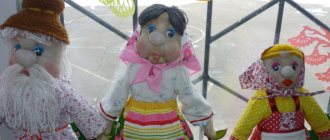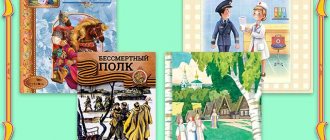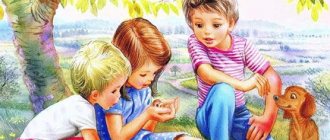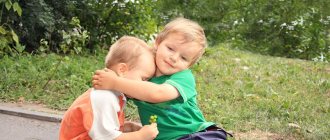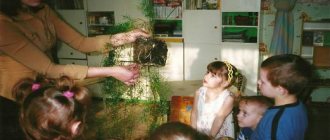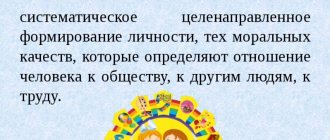We all come from childhood. Almost everyone listened to bedtime stories and imagined themselves as participants in magical adventures - the girls were fairies and princesses, the boys were the constant winners of dragons and all sorts of goblin-ghouls. But we hardly thought then that a fairy tale was a very important (if not the main!) element of our upbringing and the system of our ideas about the world, about good and evil, about work and “rewards” for laziness.
Now, sitting on the other side of the crib, it’s worth figuring out what a fairy tale is from a scientific point of view and how you can help your baby in temporary age-related or stressful situations, how can a fairy tale “cure” greed, enuresis, and fear of the dark?
So, welcome to the magical world of the fairy “wrong side”!
Where did the idea of education through fairy tales come from?
Classic of Russian pedagogy K.D. Ushinsky wrote that fairy tales are “the first and brilliant attempts of Russian folk pedagogy, and I don’t think anyone would be able to compete in this case with the pedagogical genius of the people.” The same opinion was shared by the researcher of Russian folklore V.P. Anikin, who said that “in the thought that gives life to fairy tales, the multifaceted mind of the people was manifested, their history, life, and worldview were deposited in crystals.”
One cannot argue with the value of fairy tales also because they begin to be read to children at an age when children are just beginning to form the rudiments of morality, goodwill, integrity and hard work.
A fairy tale, passing through centuries of folk wisdom, like a snowball accumulates all the most valuable things for children's preschool pedagogy. This is a unique way to raise a child not with the help of exhortations and abstract judgments, but with the help of direct experience and the actions of heroes who may or may not be loved, but are still very significant for the child. It is only important to manage this treasure wisely.
Currently, despite the obvious interest in fairy tales as an educational “tool,” there are many difficulties - the lack of consistency entails the lack of methods of pedagogical influence, and, therefore, affects the effectiveness of the pedagogical use of fairy tales. To this day, some teachers and educators find it difficult to imagine that, from the point of view of educating moral attitudes, the potential of a fairy tale is much more serious than its artistic and historical significance.
How fairy tales can be useful to parents
Fairy tales for children are not only an exciting journey into the world of fictional characters. Through fairy tales, children receive their first knowledge about the structure of life. At first glance, the world of fairy tales may seem black and white, with a clear division into good and evil. However, if we look deeper, fairy tales can also teach children a broader view of events and people. For example, the troubles and trials that befall the hero ultimately help him become stronger and more resourceful and lead to some desired changes. And sometimes in fairy tales there are ambiguous characters who, at first glance, behave like villains, and then are revealed - it is discovered that there are some reasons behind their behavior, or it was not villainous at all, but ultimately helped the hero.
Few parents know that fairy tale therapy can trigger the body’s self-regulation mechanisms. Blogger I am a Parent, clinical psychologist and certified fairytale therapist Ekaterina Blukhterova brings to your attention the therapeutic fairy tale “The Good Forest”: it will help your child find the inner strength for a speedy recovery.
How to read a fairy tale with a child
The main goal of discussing fairy tales is to build a connection between the behavior of the characters, the events occurring in the fairy tale and the real-life situations that the child faces. In this case, the plot of the fairy tale is transformed for the child into a personal store of knowledge and ideas, which he can turn to if necessary, for example, if he finds himself in some difficult situation. The famous fairytale therapist Tatyana Zinkevich-Evstigneeva suggests using the following scheme for discussing fairy tales:
A fairy tale is a lie, but there is a hint in it...
Discuss with your child what the fairy tale is about and what it teaches. Ask, in what situations in real life can what a child learned from a fairy tale be useful?
Baba Yaga vs. beautiful girl
Discuss the heroes of the fairy tale. Why does the hero perform this or that action? Why does he need this? What did he really want?
Fire, water and copper pipes
Talk about how the heroes of the fairy tale overcame difficulties. Did they turn to anyone for help? Perhaps someday your child will be able to use these methods in real life.
...a lesson to good fellows!
What feelings does this fairy tale evoke? Which episodes were particularly memorable? What episodes evoked joyful feelings? Which ones are sad? What situations caused fear?
Using the same scheme, you can discuss with your child the feature and animated films you watched together.
How to compose a fairy tale with your child
By writing fairy tales with your child, you can touch his inner world, learn about what worries him, scares him, or, on the contrary, inspires and supports him. The plot of a fairy tale is built according to certain canons: in essence, it is a sequence of events united by a certain plot.
Start by creating a main character. Give him a name and image. You can also involve art therapy here - draw a hero or sculpt him from plasticine. Find out from your child what qualities the hero has, what his character is. Discuss what your story will be about. Typically, the main character has a goal and there are obstacles to achieving it. Also in the fairy tale there are hero-allies and hero-opponents. In the process of creating a plot, try to draw parallels with the child’s real life: ask how this relates to his experience and experiences, why did he choose such a goal and such tests for the hero?
The influence of fairy tales on the moral education of children in primary school
A fairy tale is an important way of developing education in children. Since the time of Sukhomlinsky, a fairy tale has been a means that can both teach and entertain a child. The formation of personality and personal qualities, all together gives fairy tales. A fairy tale is a mentor, assistant and teacher, especially at the age of preparatory and primary schoolchildren. She gives advice, expresses emotions.
Key words: fairy tale, author's fairy tale, children's literature, types of fairy tales.
The modern world is filled with creations of human thought. Innovative technologies and information flows have become the basis of a new post-industrial stage of human development, which influences changes in the social structure of society. Many social norms are gradually being replaced by new ones, and elements of folk cultures are disappearing from everyday life.
Changes are beginning to be pervasive and affect many areas of cultural and social life. In pedagogy, for example, new educational methods and pedagogical technologies are appearing. However, we cannot exclude the role of those developments and methods that were used for educational purposes earlier. Folk culture has great educational potential. Valuable experience of moral education was preserved and carried through centuries by folk tales.
The value of fairy tales in the educational process of children in primary school cannot be overestimated. In particular, the moral aspect of education is very important.
The importance of fairy tales has been noted throughout the history of human culture. In the second half of the twentieth century, when scientific and technological revolutions began, the importance of fairy tales was noted by the Soviet writer Chingiz Aitmatov. He equated fairy tales with architectural monuments built by ancestors. Fairy tales contribute to the formation of good manners in children.
Good breeding is a personal characteristic that is reflected in the totality of integrated individual characteristics, which constitute the basis of social relationships.
Culture as a set of forms of the spiritual and moral state of society is a determining factor in the education of the personality of a growing person. The main content of education, which involves the development and appropriation of universal, personal and civic values, is realized through the formation of the basic components of personal culture.
Personal culture is based on the examples of fairy-tale heroes. Characters from fairy tales become examples for passing on certain experiences to descendants. The educational value of fairy tales has been tested and tested right up to our time. Domestic teacher Gennady Nikandrovich Volkov spoke about the need to include familiarization with folk tales in every national educational program [2].
The preservation of fairy-tale culture is ensured by its close connection with the people. There is no fixed authorship in the fairy tale. It is a product and form of oral creativity, based on real situations that occurred in the lives of ordinary people. The fairy-tale culture of an individual people contains such national traits and values as patriotism, courage, diligence in work and responsiveness of the soul. Volkov sees in fairy tales a reflection of the most striking and positive features of national culture, which are important to pass on to the future generation.
Moral values and moral norms of social relations are transmitted from adults to children through fairy tales. Fairy-tale reality becomes transitional on the path to reality. Within this reality, the child learns to act in accordance with a socially acceptable moral framework that is fundamental to a given people. The experience gained by the child in fairy-tale reality is then transferred to the surrounding social environment. Domestic teacher Vasily Aleksandrovich Sukhomlinsky noted that through fairy tales, children form their own attitude towards good and evil contained in fairy-tale images and heroes.
The educational value of fairy tales is closely related to the genre specificity of folk art. The typology of fairy tales appears to us as follows:
- about animals. This type of fairy tales is especially popular among primary school children. The characters are anthropomorphic animals leading a human lifestyle and dressing like ordinary people. The foundation of moral education and knowledge of folk culture is laid in familiarity with such fairy-tale works.
- about the relationship between people and animals. Through communication and mutual care, the child gradually comes to understand that animals are like younger brothers to us. The age of attraction of the plot is senior preschool and junior school.
- parables. The main characters, in addition to people and talking animals, can be animated inanimate objects. The end of such a tale is accompanied by a conclusion about morality or lack thereof in the actions of the main characters.
- about everyday life. Children of any preschool age can perceive such fairy tales, provided that the everyday experience described in the fairy tale is understandable.
− horror stories. Usually they are invented by children themselves for entertainment purposes. These fairy tales are most interesting in middle preschool age. However, the experience of world folk culture is rich in examples of scary fairy tales designed to tell children about what is considered unacceptable in society.
− magical. The most popular type of fairy tales. There are no restrictions or limits in fairy tales; any miracles in them seem possible.
The optimistic atmosphere of fairy tales makes the genre popular for children. The heroes do not lose heart, and even if someone is plunged into sadness, there is always a solution to the problem. The outcome of events in fairy tales often lies in the victory of good over evil. Thus, the child develops confidence in the power of truth and good intentions.
The main fairy-tale characters, who are guided by moral principles in their lives and in their actions, always come to what they want. They are lucky, help comes to them at the most needed moment, and if they make serious mistakes, they always correct them first. Fairy tales about such characters contain the main idea of justice in human relationships. If a person is honest, sympathetic and kind, then no obstacles will be scary to him [3].
One of the developers of the criteria for moral education is A.V. Zosimovsky. The scientist considers it insufficient to distinguish between two types of personality orientation, traditionally accepted in pedagogy: positive, strictly moral, and negative, immoral. He concluded that in order to regulate the educational process it is necessary to take into account the stability and strength of motivation for human behavior.
It is generally accepted to consider the social orientation of children, which is expressed in the views, beliefs, and value orientations of the individual, as an integral indicator.
The orientation of schoolchildren is manifested through leading sustainable motives of activity, through interest in certain types of social activity, through their attitude towards the world around them.
Spiritual and moral education is the formation of a value-based attitude to life that ensures sustainable, harmonious development of a person, including the cultivation of a sense of duty, honor, dignity, justice, responsibility for one’s father’s home, family, and for harmony in the family. The formation of such moral feelings as duty, faith, conscience, patience, mercy, meekness, love, understanding of good and evil takes place [1].
With the help of fairy tales, it is as if a child starts a piggy bank, into which he puts various pieces of advice, actions, and situations. Thus, he will always have examples of what can be done and what cannot be done. With a fairy tale, we show that there is always a choice and you yourself will be responsible for this choice. It is important to show that even if you see only two paths, and they do not suit you, there will definitely be a third.
Moral education is an important element in the development of modern society and the integration of children into the social structure. Familiarization with works of fairy-tale content promotes the assimilation of generally accepted national moral norms.
Fairy tales play an important role in the educational process. They are a field for the perception of national values and the formation of confidence in justice, passing on the people's experience accumulated over centuries. Models of socially acceptable behavior and examples of virtuous and honest actions contain fairy tale stories to which the child will have constant access.
Literature:
- Federal program for the development of education.
- Volkov, G. N. Ethnopedagogy / G. N. Volkov. - M., 2000. - 169 p.
- Khaitova N. I. Folk tale as a means of moral education of children of primary school age / N. I. Khaitova // Bulletin of pedagogy and psychology of Southern Siberia. - No. 1. - 2015. - 17–23 p.
How to come up with new endings to existing fairy tales
Sometimes, in order to help a child find a solution to a problem through a fairy tale, you don’t need to compose a new one. It is enough to come up with a new ending to one of those that already exists. Here it is important to choose a fairy tale whose key problem will coincide with the one that is currently relevant for the child. For example, if a child is worried about a strict teacher who gives a lot of tasks or gives low grades, you can discuss the fairy tale about Cinderella with him.
In fairy tales, magic often comes to the aid of the main character. Cinderella, for example, is protected from her stepmother by her fairy godmother. How could Cinderella cope on her own, without magical help? Was her stepmother so unfair to her, since Cinderella herself ran away without completing the “homework” left to her? Did Cinderella have any options to negotiate with her stepmother?
So, with the help of fairy tale therapy, you can help your child change his attitude towards a situation that he experiences as hopeless or unfair. With your help, he will learn to look at the problem from different angles, look for options and not feel small and helpless.
Anna Kolchugina
Does your child believe in miracles? Find out together! TAKE THE TEST!
